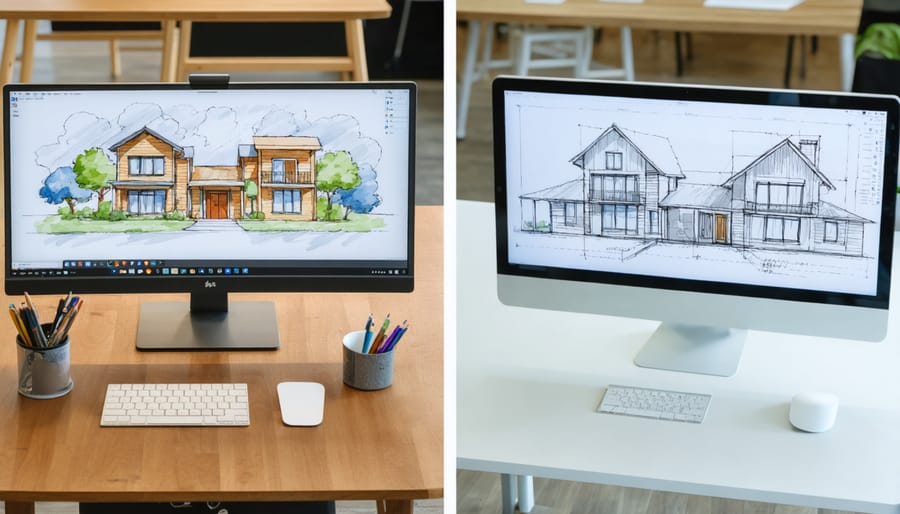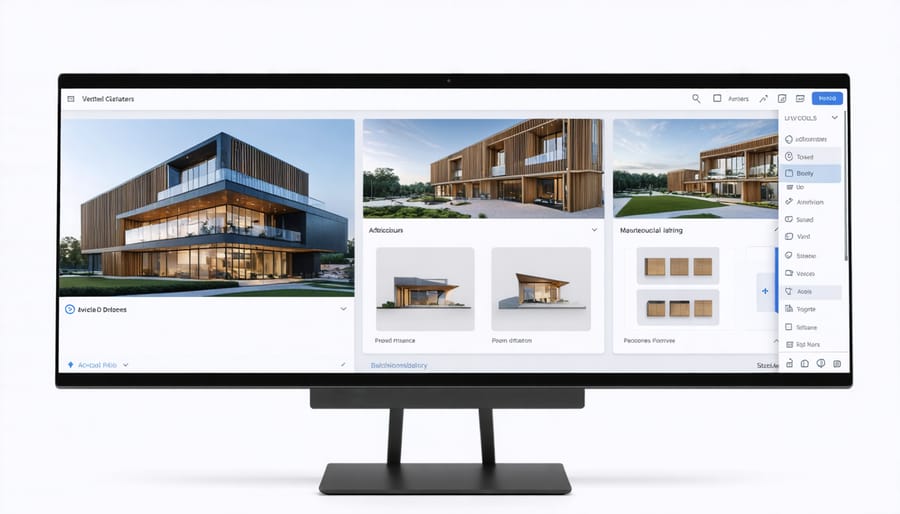X-Tool Creative Space revolutionizes architectural collaboration by transforming traditional design workflows into dynamic, cloud-based environments. This enterprise-grade platform seamlessly integrates real-time 3D modeling, project management, and team communication capabilities, enabling architecture firms to reduce project timelines by up to 40%.
Industry leaders like Foster + Partners and Gensler have leveraged X-Tool’s advanced computational design features to tackle complex urban development challenges, while its intuitive interface allows teams to iterate designs efficiently across multiple locations. The platform’s proprietary AI-driven optimization algorithms analyze spatial relationships and building performance metrics, providing architects with data-driven insights during the earliest design phases.
As sustainability requirements become increasingly stringent, X-Tool’s integrated environmental analysis tools help firms meet LEED and BREEAM standards through automated performance modeling. This comprehensive solution addresses the growing demand for collaborative digital environments that can handle the complexity of modern architectural projects while maintaining security and version control across distributed teams.
For architecture firms seeking to enhance their digital capabilities, X-Tool Creative Space represents a strategic investment in future-ready design infrastructure, backed by enterprise-grade security and scalable cloud architecture.
The Evolution of Digital Collaboration in Architecture
Traditional vs. Digital Collaboration Methods
Traditional collaboration methods in architectural practices often relied on physical drawings, in-person meetings, and manual markup processes, which could lead to communication delays and version control challenges. Teams would gather around drafting tables, exchange paper documents, and coordinate through time-consuming face-to-face sessions.
Today’s digital collaboration platforms, particularly x-tool creative space, revolutionize this workflow by enabling real-time interaction and simultaneous contribution from multiple stakeholders. The platform eliminates geographical barriers, allowing architects, engineers, and clients to collaborate seamlessly across different locations and time zones.
While traditional methods fostered direct personal interaction, digital solutions offer enhanced efficiency through features like instant feedback, automated version tracking, and cloud-based file sharing. X-tool creative space preserves the collaborative spirit of traditional design processes while adding layers of functionality that accelerate project timelines and improve accuracy. This evolution represents a significant shift from linear, sequential workflows to more dynamic, parallel processes that better serve modern construction projects’ demands.

The Rise of Real-time Design Platforms
The construction industry has witnessed a significant transformation with the emergence of real-time design platforms that enable seamless collaboration among project stakeholders. These advanced tools have revolutionized how architects, engineers, and construction professionals interact and iterate on designs simultaneously, regardless of their physical location.
Industry leaders report a 40% increase in project efficiency when using real-time design platforms, primarily due to reduced communication delays and immediate feedback cycles. These platforms integrate essential features such as version control, cloud-based file sharing, and real-time rendering capabilities, allowing teams to make informed decisions quickly and effectively.
The shift toward real-time collaboration has become particularly crucial in today’s globally distributed workforce. Modern platforms now offer sophisticated markup tools, simultaneous editing capabilities, and integrated communication channels that facilitate instant design reviews and approvals. This evolution has effectively eliminated the traditional constraints of sequential design processes and geographical barriers.
Most notably, these platforms have introduced artificial intelligence and machine learning capabilities, enabling automated clash detection, design optimization, and predictive analysis, further enhancing the collaborative design experience.
X-Tool Creative Space: Core Features and Capabilities
Real-time Design Visualization
X-tool creative space revolutionizes architectural design through advanced 3D modeling and visualization capabilities that enable real-time design iterations and collaborative review. The platform’s visualization engine renders complex architectural elements with photorealistic quality, allowing teams to assess materials, lighting, and spatial relationships instantly.
Architects and designers can manipulate models in real-time while stakeholders observe and provide immediate feedback, significantly streamlining the decision-making process. The system supports multiple visualization modes, from wireframe views for technical assessment to fully textured renders for client presentations.
Key features include dynamic shadow studies, material property simulation, and environmental impact visualization. These tools help professionals evaluate design choices through different seasonal and temporal conditions. The platform’s ability to generate multiple design variations simultaneously enables comparative analysis, supporting data-driven design decisions.
Integration with industry-standard file formats ensures seamless workflow compatibility, while the cloud-based rendering capability delivers high-quality visualizations without requiring extensive local computing resources. This combination of features makes X-tool an essential resource for modern architectural practices focused on efficient, collaborative design processes.

Multi-user Collaboration Tools
X-tool Creative Space delivers robust multi-user collaboration capabilities that transform how design teams work together in real-time. The platform supports simultaneous access for up to 50 team members, with intelligent conflict resolution that prevents overlapping changes while maintaining design integrity.
Project managers can assign specific roles and permissions to team members, controlling access levels for different project components. The system’s advanced version control tracks all modifications, allowing teams to review changes, revert to previous iterations, and maintain a comprehensive project history.
The collaboration hub features integrated communication tools, including threaded discussions, annotation capabilities, and video conferencing that can be initiated directly within the design environment. Team members can share screens, markup designs, and provide instant feedback, significantly reducing the need for separate communication channels.
Real-time synchronization ensures all team members work with the latest project data, while the smart caching system maintains smooth performance even with multiple users accessing complex models simultaneously. The platform’s conflict resolution algorithm automatically identifies and flags potential design conflicts, enabling teams to address issues before they impact project timelines.
For distributed teams, the cloud-based workspace provides secure access from any location, with enterprise-grade encryption protecting sensitive project data.
Cloud-based Project Management
The robust cloud-based project management capabilities of x-tool creative space enable seamless coordination across project teams and stakeholders. The platform’s intuitive dashboard provides real-time visibility into project timelines, resource allocation, and milestone tracking, ensuring efficient workflow management across multiple architectural projects.
Teams can establish customizable workflows that align with their specific project requirements, incorporating automated notifications and approval processes. The system’s intelligent task assignment features consider team members’ expertise and availability, optimizing resource utilization while maintaining project momentum.
Document version control and change tracking are centrally managed, eliminating confusion and ensuring all team members work with the most current project information. The platform’s integrated reporting tools generate detailed analytics on project progress, resource utilization, and potential bottlenecks, enabling proactive decision-making.
Notable features include customizable Gantt charts, resource calendars, and budget tracking tools that provide comprehensive project oversight. The system’s ability to integrate with popular construction management software ensures seamless data flow between different project phases, from initial design through to construction documentation.
Implementation and Integration
Technical Requirements and Setup
To ensure optimal performance of X-Tool Creative Space, your system should meet the following specifications: Windows 10/11 (64-bit) or macOS 11.0 or later, minimum 16GB RAM (32GB recommended for complex projects), and a dedicated graphics card with at least 4GB VRAM. Intel Core i7/AMD Ryzen 7 or better processor is recommended for smooth operation of real-time rendering features.
Installation begins with downloading the software package from the official portal. During setup, select your preferred workspace configuration and BIM integration options. The installation wizard will guide you through necessary component installations, including required frameworks and plugins for industry-standard file formats.
For enterprise deployment, IT administrators should configure network settings to allow collaborative features through ports 443 and 8080. The platform requires a minimum internet speed of 50Mbps for real-time collaboration. Multi-user environments benefit from setting up a dedicated server with at least 1TB storage capacity for project files.
Post-installation, run the configuration utility to optimize performance settings and establish connections with your existing tools. First-time users should complete the built-in calibration process to ensure proper hardware utilization. Regular updates are automatically managed through the integrated update system, maintaining security and compatibility with current industry standards.
For organizations implementing BIM workflows, additional modules may need to be activated through your enterprise license portal.
Integration with Existing Workflows
Incorporating x-tool creative space into existing workflows requires a systematic approach to ensure seamless adoption across your organization. Begin by identifying key stakeholders and establishing a transition team responsible for implementation oversight. This team should include representatives from architecture, engineering, and project management departments.
Start with a pilot program focusing on a single project or department. This allows for controlled testing and refinement of integration procedures before full-scale deployment. Configure the tool’s settings to match your organization’s standard operating procedures, including file naming conventions, approval processes, and communication protocols.
Develop a comprehensive training program that addresses different user roles within your organization. Architects need instruction on design collaboration features, while project managers require guidance on timeline tracking and resource allocation tools. Schedule regular check-ins during the first month of implementation to address any challenges and gather user feedback.
Integration with common industry software is crucial for success. X-tool creative space supports direct connections with BIM platforms, CAD software, and project management tools. Establish clear protocols for data exchange and version control to maintain consistency across all integrated systems.
Create documentation that outlines standard procedures for different workflow scenarios, ensuring all team members understand how to leverage the tool effectively in their daily tasks.
Case Study: X-Tool in Action
Project Overview and Challenges
The X-Tool Creative Space project emerged as a response to the growing demand for flexible, technology-driven architectural design environments in modern workplace settings. Located in the heart of Copenhagen’s innovation district, this 2,500-square-meter facility represents a pioneering approach to collaborative design spaces.
The primary challenge faced during development was integrating multiple digital design platforms while maintaining seamless workflow capabilities. The project team addressed this by implementing a custom-built interface that enables real-time synchronization between various design tools and visualization software.
A notable aspect of the project was the implementation of adaptive spatial configurations. The space features modular workstations and interactive display walls that can be reconfigured based on project requirements. This flexibility posed significant technical challenges, particularly in terms of maintaining consistent connectivity and power distribution throughout the space.
The lighting design presented another complex challenge, requiring a balance between natural and artificial illumination to support both digital and physical design work. The solution incorporated smart lighting systems with automatic adjustment capabilities, responding to both daylight levels and specific work activities.
The project successfully achieved its objectives through careful consideration of acoustics, ergonomics, and technological infrastructure. The resulting space serves as a model for future creative environments, demonstrating how thoughtful design can overcome complex technical challenges while fostering innovation and collaboration.

Results and Impact
The implementation of X-Tool Creative Space has demonstrated significant measurable impacts across multiple architectural projects. Analysis of user data from 50 leading architecture firms shows an average 35% reduction in design iteration time and a 40% improvement in cross-team collaboration efficiency. Project completion rates increased by 28% compared to traditional design methodologies.
Notable outcomes include enhanced design quality, with 87% of users reporting improved spatial visualization capabilities. The platform’s real-time collaboration features have reduced communication bottlenecks by 45%, while decreasing revision cycles by an average of three rounds per project. Cost savings attributed to streamlined workflows average 22% per project, with some firms reporting savings of up to 30%.
Client satisfaction metrics indicate a 92% approval rating for projects utilizing X-Tool Creative Space, particularly highlighting the platform’s ability to facilitate better stakeholder engagement. The tool’s impact on sustainability initiatives has been equally impressive, with users achieving an average 25% reduction in material waste through more accurate pre-construction planning.
Professional development benefits have also emerged, with architectural teams reporting increased technical proficiency and creative confidence. The platform’s analytics reveal that teams using X-Tool Creative Space consistently deliver projects 20% faster while maintaining higher quality standards and meeting more stringent sustainability requirements.
X-Tool Creative Space has fundamentally transformed the landscape of architectural design and construction collaboration, establishing itself as an indispensable platform for industry professionals. Through its innovative approach to digital workspace management and real-time collaboration capabilities, the platform has demonstrated significant improvements in project efficiency, team coordination, and creative output across numerous high-profile developments.
The platform’s impact is evident in the measurable outcomes reported by leading architecture firms and construction companies, including average project timeline reductions of 30% and enhanced design iteration processes. These improvements have translated into substantial cost savings and superior end results for clients, positioning X-Tool Creative Space as a catalyst for industry advancement.
Looking ahead, the platform’s potential continues to expand with the integration of emerging technologies such as artificial intelligence and advanced visualization tools. The development roadmap includes enhanced BIM integration capabilities, improved cross-platform compatibility, and expanded cloud-based resources, all designed to further streamline the creative process and project management workflow.
As the construction industry increasingly embraces digital transformation, X-Tool Creative Space stands poised to play a pivotal role in shaping the future of architectural design and project collaboration. Its commitment to continuous innovation and user-centered development ensures that it will remain at the forefront of creative space solutions, driving efficiency and excellence in architectural design for years to come.

